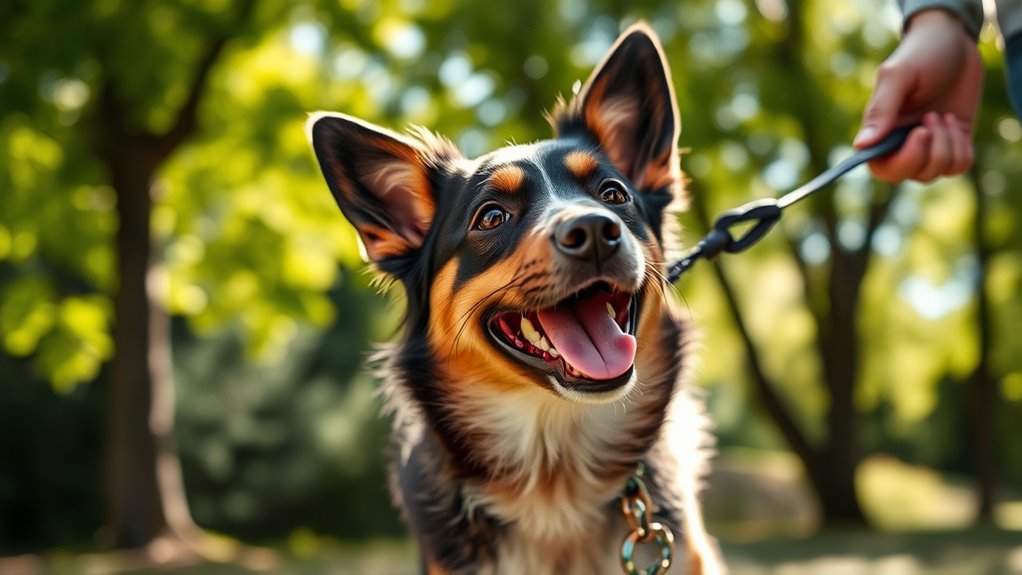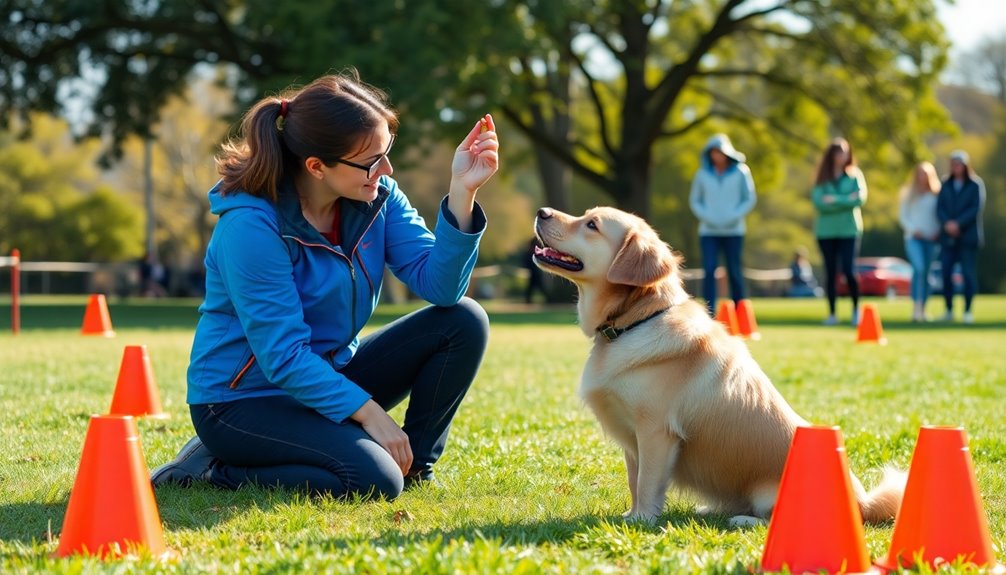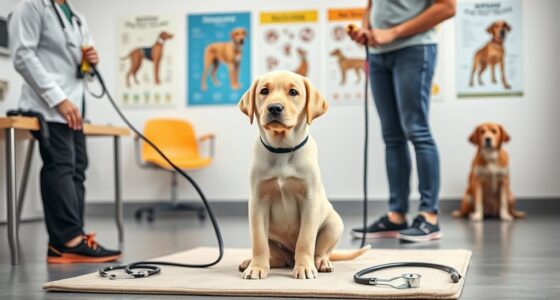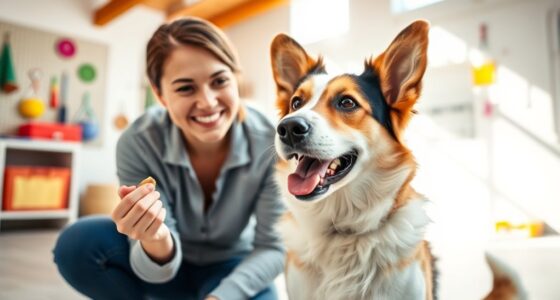To stop pulling instantly, focus on consistency and positive reinforcement. When your dog pulls, stop walking immediately and stand still until they loosen the leash or return to you. Praise or reward calmly walking dogs and use clear commands to redirect attention. Keep sessions short and upbeat, gradually increasing difficulty. With patience and persistence, your dog will learn to walk calmly by your side. Keep going to discover more effective tricks that can make a difference quickly.
Key Takeaways
- Immediately stop walking when pulling begins, and stand still until the dog relaxes or returns to your side.
- Use a firm, kind “no” or “uh-uh” to correct pulling, then reward when the dog walks calmly.
- Practice quick, short training sessions with positive reinforcement to reinforce good leash manners instantly.
- Redirect attention with commands or treats if the dog gets distracted or pulls during walks.
- Consistently vary your walking environment and routines to reduce overstimulation and promote calm, controlled leash behavior.

Leash training is an essential step in ensuring your dog walks calmly and safely by your side. When you focus on proper leash training, you’re not just teaching your dog to walk without pulling; you’re also helping them develop good social skills and understanding of leash safety. Dog socialization plays a key role here because a well-socialized dog feels more comfortable around other animals and people, reducing the likelihood of pulling out of excitement or fear. The more your dog interacts positively during walks, the better they’ll respond to your cues and stay calm. To start, choose a suitable collar or harness that fits comfortably and doesn’t cause discomfort. This helps your dog feel secure and reduces the chances of them pulling or slipping free, which is vital for leash safety.
Next, establish a consistent routine. Use short, engaging training sessions to build your dog’s confidence and reinforce good behavior. When your dog begins to pull, stop walking immediately and stand still, gently correcting with a firm but kind “no” or “uh-uh.” Wait until they come back to your side or loosen the tension on the leash, then reward with praise or treats. This teaches your dog that pulling won’t get them where they want to go, but walking calmly at your side does. Be patient—training takes time, and consistency is key.
Incorporate positive reinforcement to make leash training enjoyable. Whenever your dog walks without pulling or responds to commands, reward them immediately. This could be a treat, praise, or a favorite toy. Over time, your dog will associate walking calmly with positive outcomes. Additionally, practice leash safety by avoiding distractions that might tempt your dog to pull, such as other dogs, loud noises, or interesting scents. Use your body language to communicate clearly—stand tall, hold the leash firmly but gently, and keep your movements predictable. This helps your dog understand that you’re in control, which boosts their confidence and reduces anxiety.
Dog socialization isn’t just about meeting other dogs; it also involves getting your dog accustomed to various environments, sounds, and people. The more varied the experiences during walk time, the less likely your dog will pull out of overstimulation or uncertainty. The right leash or harness can also influence how comfortable and confident your dog feels during walks. Always stay alert to your surroundings and your dog’s behavior. If your dog starts to pull or gets distracted, calmly redirect their attention back to you with commands they know well. Remember, leash safety is paramount—never yank or jerk the leash, as this can cause injury or anxiety. Instead, focus on gentle corrections and consistent training, and soon, your dog will walk politely by your side, making every walk safer and more enjoyable for both of you.
Frequently Asked Questions
How Long Does Leash Training Typically Take?
The training duration varies depending on your dog’s temperament and consistency. Some dogs pick up leash manners within a few days, while others may take several weeks. You’ll see progress faster if you stay patient and practice regularly. Remember, every dog learns at its own pace. Keep sessions positive and frequent, and you’ll be able to see results in a reasonable timeframe, tailored to your dog’s individual needs.
Can Leash Training Be Done Indoors Only?
You can definitely do leash training indoors only, especially if outdoor space is limited. Indoor exercises with your dog are effective, using training accessories like adjustable leashes to reinforce commands. Starting inside helps your dog focus without distractions, making it easier to learn proper leash manners quickly. Plus, consistent practice indoors builds a strong foundation, so when you take training outside, your pup is already on the right track.
What if My Dog Refuses to Walk on a Leash?
If your dog refuses to walk on a leash, it’s common to face dog patience and leash frustration. You can start by making the leash a positive experience, using treats and praise. Keep sessions short and gradually increase time. Stay calm and patient, avoiding force. Consistent, gentle training helps your dog feel safe, easing their leash refusal and turning walks into enjoyable adventures for both of you.
Are There Specific Harnesses Better for Training?
Imagine finding the perfect harness that turns your walks into pure joy! For training, look for harnesses with exceptional harness comfort and excellent leash compatibility. A well-designed harness reduces pulling, offers better control, and keeps your dog comfortable during long walks. Some harnesses are specifically made for training, featuring front attachments that discourage pulling. Choose one that fits snugly, feels comfortable, and works seamlessly with your leash for the best training results.
How Do I Prevent Leash Reactivity During Training?
You can prevent leash reactivity by using counter conditioning and desensitization techniques. Start by exposing your dog to triggers at a distance where they remain calm, rewarding calm behavior consistently. Gradually decrease the distance over time, pairing each exposure with treats and praise. This process helps your dog associate triggers with positive experiences, reducing reactivity. Patience and consistency are key to success in managing leash reactivity effectively.
Conclusion
Stop pulling now, and enjoy the walk. Stop pulling now, and build trust. Stop pulling now, and create respect. With these simple tricks, you’ll turn chaos into calm, frustration into fun, and training into teamwork. Remember, consistency is key—be patient, stay positive, and adapt as you go. When you stop pulling, you open the door to a better bond, a happier journey, and a lifelong friendship. Keep at it, and watch your leash training transform your walks forever.










